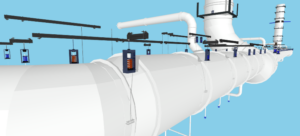As microprocessors continually get smaller, manufacturing becomes more accurate, working on the nanometer scale which is highly intolerant to disruption.
To create the environment needed to facilitate precision manufacturing, it is essential to control vibration, temperature, humidity and particulates. Here’s how vibration control specialist, Mason UK, designed a sophisticated vibration isolation system to ensure conditions at an advanced manufacturing site in Ireland were ideal for high-precision manufacturing.
Mason UK was commissioned to provide vibration isolation support at a vast site upgrade project in Ireland. In fact, the site is one of the most technologically advanced manufacturing locations in Europe and the facility has undergone an upgrade that has enabled production of 14nm process technology.

Meeting the specification
Mason UK was brought on board by the contractor early to support the design. What makes this project unique is the scale of the facility and volume of vibration control required. As a result, not only the vibration but factors such as wind loading, thermal expansion and the clash of services in a crowded area had to be considered.
As one of the biggest construction projects that Ireland has ever seen, the shear amount of product that Mason UK supplied was staggering. In total the vibration specialist has so far supplied 3800 spring mounts, 1600 hangers and 400 flexible pipe connectors for the site. With such an unprecedented undertaking ahead, it is little wonder that there was a very onerous specification.
“The first requirement is ensuring quality of the engineering design, for example, specifying a particular spring geometry or housings made in a certain way,” explained Adam Fox, director at Mason UK. “The second requirement is ensuring the product has the correct vibration isolation properties. This is determined initially by the location in the building and the experienced product selection of the Mason UK engineering team.
“The closer you get to the fabrication, the more urgent the need for vibration isolation. Similarly, the higher up you go in the building, the more lightweight the structure gets, and more vibration isolation is necessary. Down in the foundations, vibration is minimal, but if you’re on the roof, that roof structure can be quite sympathetic to vibration. The vibration isolation properties can also be equipment driven. By and large, the bigger the diameter of your pipe, the bigger your pump or your ducting gets and the more energy it is able to carry. Consequently, larger pipes require a higher level of vibration isolation.”
Design support like no other
Not only was Mason UK brought on board to supply the vibration control products, but the team was also invited to conduct associated design work. Mason UK has unrivalled design capabilities in this area, so this was a welcome invitation for its experienced engineers.
The team took 3D models of the ducts and supporting steels and generated their own drawings using building information modelling software, Revit. Mason UK also produced detailed 2D drawings using AutoCAD. These were used to calculate how much each component weighs, how much it expands and how much it contracts. This process was repeated for hundreds of pieces of plant equipment and kilometres of building services, for all locations and configurations, to show which products were required and where. Crucially, this removed some responsibility from the contractor.
However, the project was not without its engineering challenges. Instead of simply supplying a standard catalogue product, Mason UK made bespoke spring mounts with different housing to meet the needs of this project. This allowed for clearance on vertical ducts when they grow and shrink thermally.
As with any project of this magnitude, smooth installation is key. The physical size of the products, some of which were half a metre in height and a vast range of sizes, could have proved tricky. Mason UK went above and beyond to help simplify the process. The company anticipated that it would be difficult to detail all duct supports and created bespoke spring mounts, with consistent dimensions and attachments. This ultimately made the installation cheaper and easier.
Quality of product
Mason UK also supplied flexible connectors for the project to isolate the pumps from the ground. The flexible pipe connectors selected were the Safeflex variety, using a uniquely robust flange design and reinforced with Kevlar, which has immense strength and fantastic resistance to becoming brittle over time. Cheaper variations use nylon and can become brittle if heated water passes through it. This can lead to failure which is absolutely unacceptable for a continually running fabrication process.
“No one else builds connectors in this way,” continued Fox. “With the vast majority of connectors, you snap them on to their flange — but if you can snap them on, you can also snap them off. We use a solid steel ring which is bolted in place so that there’s no way it can snap out and fail.
“Our connectors can accept steam or chemicals passing through at high pressure and temperatures. If it were to burst, severe injury or flooding can result. From damage to equipment, to whole buildings being written off — the repercussions would be huge. Our Safeflex flexible pipe connectors are such a reliable design that we’ve never had a failure.”
While this project was clearly a massive engineering exercise, the quality and reliability of Mason UK’s products, coupled with the company’s unrivalled design expertise, proved invaluable to ensure the upgrade will be a success.
















